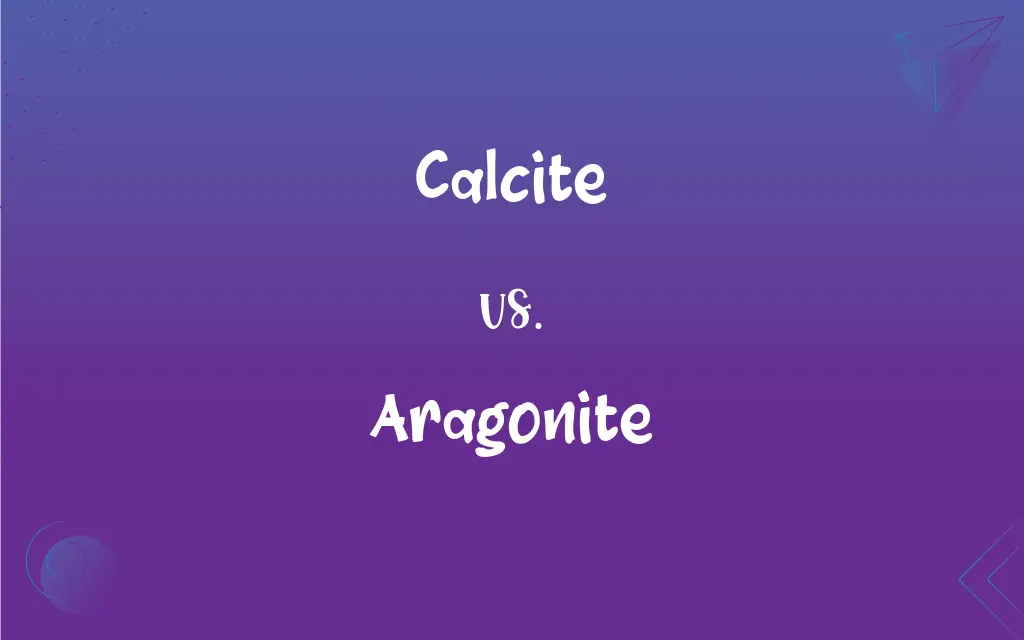Calcite vs. Aragonite: What's the Difference?
Edited by Aimie Carlson || By Janet White || Published on February 26, 2024
Calcite is a common form of calcium carbonate with a trigonal crystal structure, while aragonite, also calcium carbonate, has an orthorhombic crystal structure.

Key Differences
Both calcite and aragonite are forms of calcium carbonate (CaCO3), but they differ in their crystal structure. Calcite crystallizes in a trigonal system, contributing to its stability and wide occurrence in nature. Aragonite, with an orthorhombic crystal system, is less stable at surface temperatures and pressures.
Calcite often forms scalenohedral crystals and has a broader range of colors. It also exhibits strong double refraction, where objects viewed through a clear piece appear doubled. Aragonite typically forms needle-like crystals and is usually colorless or white, although impurities can add color.
Calcite is the most stable polymorph of calcium carbonate at most Earth surface conditions and is a primary component of limestone and marble. Aragonite forms in biological environments and is common in mollusk shells and coral.
Calcite is widely used in various industries, including construction (as a building material and aggregate), agriculture (soil treatment), and manufacturing (as a component in cement). Aragonite's main use is in jewelry, and due to its relative instability, it's less common in industrial applications.
Aragonite is thermodynamically less stable than calcite at standard temperature and pressure and can transform into calcite over geological time scales. Calcite remains stable under a broader range of environmental conditions.
ADVERTISEMENT
Comparison Chart
Crystal Structure
Trigonal
Orthorhombic
Color and Appearance
Broader range of colors, strong double refraction
Typically colorless or white, needle-like crystals
Occurrence and Formation
Stable at surface conditions, in limestone and marble
Common in biological environments like shells
Uses and Applications
Extensive in construction, agriculture, manufacturing
Mainly in jewelry, less common industrially
Stability and Transformation
Stable under most conditions, doesn’t transform easily
Less stable, can transform into calcite over time
ADVERTISEMENT
Calcite and Aragonite Definitions
Calcite
Calcite is a naturally occurring calcium carbonate mineral with a trigonal crystal form.
The clear calcite crystal displayed strong double refraction.
Aragonite
Aragonite is less stable at Earth's surface conditions compared to calcite.
Over time, the aragonite in the fossil slowly transformed into calcite.
Calcite
Calcite is known for its wide variety of colors and crystal shapes.
The colorful calcite specimens were a highlight of the mineral collection.
Aragonite
Aragonite is a crystal form of calcium carbonate, known for its orthorhombic structure.
The aragonite crystals formed delicate, needle-like shapes.
Calcite
Calcite is a common and versatile mineral, a primary component of limestone and marble.
The marble statue, composed mainly of calcite, had a smooth finish.
Aragonite
Aragonite is often used in jewelry, particularly when it forms in attractive, colorful clusters.
The aragonite jewelry was prized for its unique and intricate crystal formations.
Calcite
Calcite is a mineral with a Mohs hardness of 3, known for its double refraction property.
Using calcite, scientists demonstrated the phenomenon of double refraction.
Aragonite
Aragonite is a mineral commonly found in mollusk shells and as a byproduct of biological processes.
The seashell's luster was due to the aragonite layers within.
Calcite
Calcite is a major mineral in sedimentary rocks and a key component in earth's carbon cycle.
The sedimentary rock was rich in calcite, indicating a marine origin.
Aragonite
Aragonite serves as an indicator mineral for understanding past environmental conditions.
The presence of aragonite in the sediment core suggested warmer ocean temperatures in the past.
Calcite
A common crystalline form of natural calcium carbonate, CaCO3, that is the basic constituent of limestone, marble, and chalk. Also called calcspar.
Aragonite
An orthorhombic mineral form of crystalline calcium carbonate, dimorphic with calcite.
Calcite
(mineral) a very widely distributed crystalline form of calcium carbonate, CaCO3, found as limestone, chalk and marble
Aragonite
(mineral) An evaporite consisting of anhydrous calcium carbonate with the chemical formula CaCO3; it is dimorphous with calcite.
Calcite
Calcium carbonate, or carbonate of lime. It is rhombohedral in its crystallization, and thus distinguished from aragonite. It includes common limestone, chalk, and marble. Called also calc-spar and calcareous spar.
Aragonite
A mineral identical in composition with calcite or carbonate of lime, but differing from it in its crystalline form and some of its physical characters.
Calcite
A common mineral consisting of crystallized calcium carbonate; a major constituent of limestone
Aragonite
A mineral form of crystalline calcium carbonate; dimorphic with calcite
FAQs
What is calcite?
A common mineral form of calcium carbonate with a trigonal crystal structure.
Where is calcite commonly found?
In sedimentary rocks like limestone and in marble.
Is aragonite stable at surface conditions?
It's less stable than calcite and can transform into calcite over time.
Can calcite be colorful?
Yes, it can appear in various colors depending on impurities.
Does calcite exhibit double refraction?
Yes, objects viewed through clear calcite appear doubled.
What is aragonite?
A form of calcium carbonate with an orthorhombic crystal structure.
What are the main uses of aragonite?
Mainly in jewelry and as an environmental indicator.
What is the Mohs hardness of calcite?
It has a hardness of 3 on the Mohs scale.
Can aragonite be synthetically produced?
Yes, it can be synthetically formed under controlled conditions.
Is aragonite used in industrial applications?
Less commonly, due to its lesser stability compared to calcite.
Is calcite used in construction?
Yes, as a building material and in cement.
What differentiates aragonite from calcite in jewelry?
Aragonite forms more intricate and needle-like crystal shapes.
What role does calcite play in the carbon cycle?
It's a key component in the carbon cycle, particularly in ocean chemistry.
What is a common test to identify calcite?
The acid test, where it reacts vigorously with dilute hydrochloric acid.
How does aragonite transform into calcite?
Through geological processes involving changes in temperature and pressure.
Are there any cultural or historical significances to calcite?
It has been used throughout history in art and architecture.
Where does aragonite commonly form?
In marine environments, like in coral and mollusk shells.
How does calcite interact with acids?
It reacts with acids, even weak ones, and effervesces.
Is aragonite found in freshwater environments?
It's more commonly found in marine settings.
Does aragonite form in specific temperatures?
It tends to form in warmer water temperatures.
About Author
Written by
Janet WhiteJanet White has been an esteemed writer and blogger for Difference Wiki. Holding a Master's degree in Science and Medical Journalism from the prestigious Boston University, she has consistently demonstrated her expertise and passion for her field. When she's not immersed in her work, Janet relishes her time exercising, delving into a good book, and cherishing moments with friends and family.
Edited by
Aimie CarlsonAimie Carlson, holding a master's degree in English literature, is a fervent English language enthusiast. She lends her writing talents to Difference Wiki, a prominent website that specializes in comparisons, offering readers insightful analyses that both captivate and inform.































































